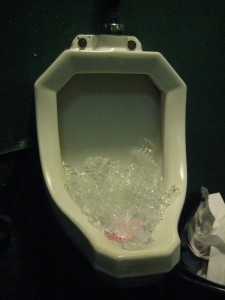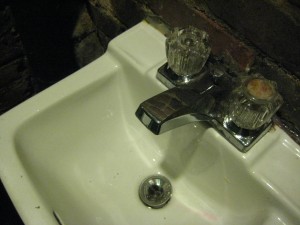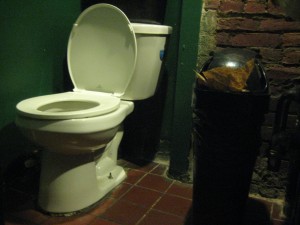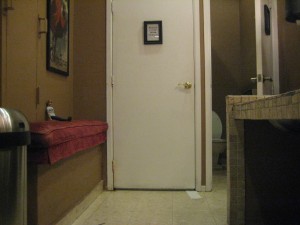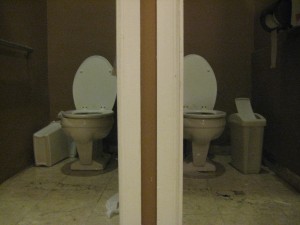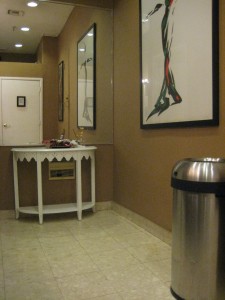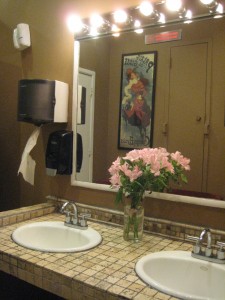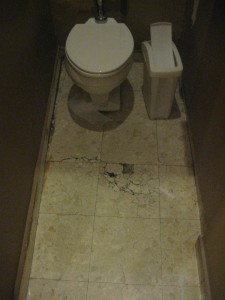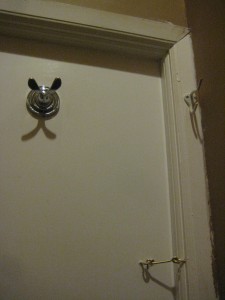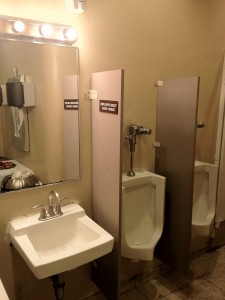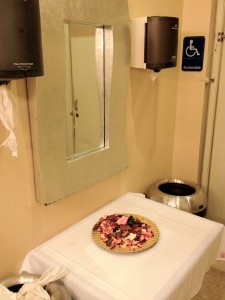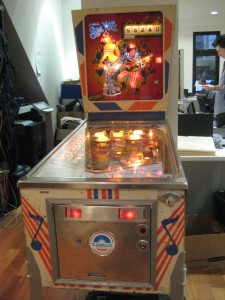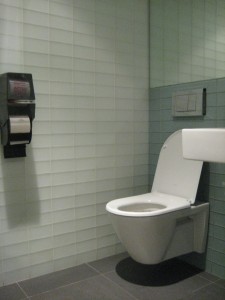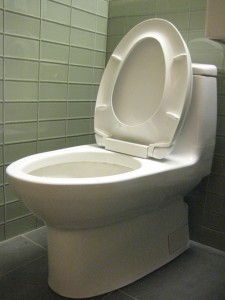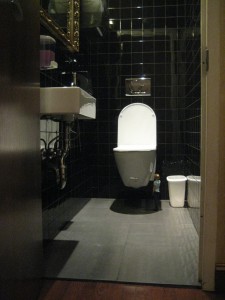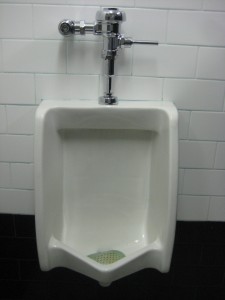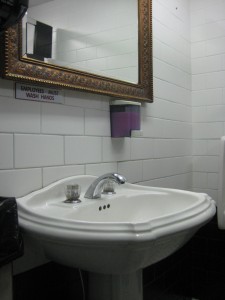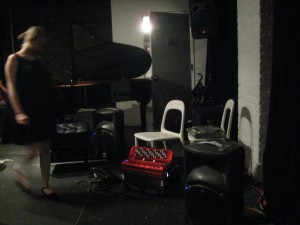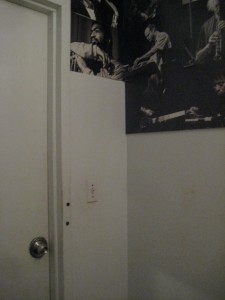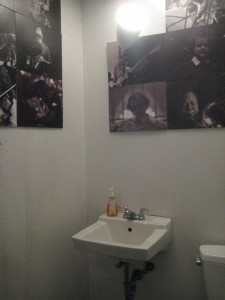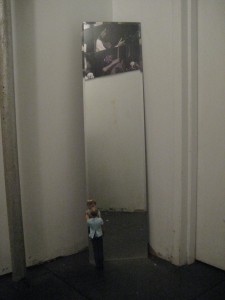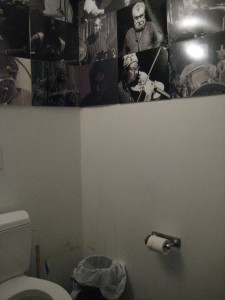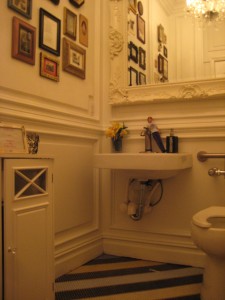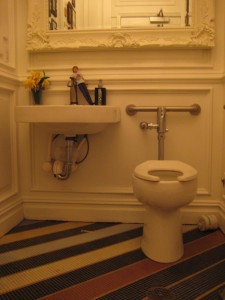55 Bar
Posted: October 9, 2012 Filed under: Greenwich Village | Tags: TUESDAY TOILET TALK Comments Off on 55 BarAfter an earlier round of hot cocoa at Caffe Reggio, I walked over a few blocks to the 55 Bar. Greeted by the plethora of “2 DRINK MINIMUM PER SET” signs, I dutifully ordered grapefruit juice, which came in a heavy glass beer mug with a straw. After that, I didn’t feel that I could handle any more beverages and also didn’t want to run out to the ATM to make sure I had enough cash for the tip jar so I asked to purchase a bottle of water. The bartender replied, “we don’t sell bottled water—keep jazz alive.”
Keep jazz alive. I hardly think that the two-drink minimum is keeping jazz alive. If anything, it may be elongating a slow and painful death. Sure, the minimum is allowing the 55 Bar to stay open on a month-to-month basis but sustaining jazz through an IV drip is not the answer. A fundamental restructuring of the organization seems necessary to resuscitate the jazz economy, though I’m not sure what that would look like. I thought about this between sips of ginger ale, which the bartender poured into the beer mug I was using previously. I must have contributed a few more cents into the “keep jazz alive” jar by forgoing the labor cost required to wash an extra mug. Someone please give me a bumper sticker.
I don’t mean to get dark on 55 Bar—it’s a good venue, especially if you remember to sit along the bar so that you can get a full view of the band. There’s a somewhat festive atmosphere with icicle lights strung all around and a Christmas bow and a St. Patrick’s Day clover cutout behind the bar. The walls are adorned with many posters, album covers and a charming old clock that displays the wrong time. With a case of Samuel Adams and a box of Swiss Miss in plain view, it can feel like you are in a giant pantry, decorated by Christmas lights. This may be the closest you get to understanding how the Indian in the Cupboard felt.
While waiting in line for the ladies room, I couldn’t help but peek into the men’s room to see the urinal filled with ice. I wonder what that’s about. Both restrooms are sufficient in size for one person to use. The ladies has two trash bins and several rolls of toilet paper readily available.
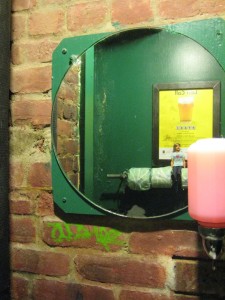 When I visited two Wednesdays ago, percussionist Rogério Boccato’s quartet with Nando Michelin (keyboard), Jay Anderson (bass) and Dan Blake (sax) played sets of music from the post Bossa Nova generation. In between listening to this ensemble led by the ethnically Italian percussionist from Brazil, I talked to my ethnically Japanese friend Yumi from France about her life back home and in the city. She mentioned that while she never identified as an Asian in France, she thinks about it all the time here. On the other hand, while French peers requested an explanation as to how she can be both fully French and Asian simultaneously, New Yorkers don’t require an explanation of her Asian-ness, perceiving her simply as a foreigner.
When I visited two Wednesdays ago, percussionist Rogério Boccato’s quartet with Nando Michelin (keyboard), Jay Anderson (bass) and Dan Blake (sax) played sets of music from the post Bossa Nova generation. In between listening to this ensemble led by the ethnically Italian percussionist from Brazil, I talked to my ethnically Japanese friend Yumi from France about her life back home and in the city. She mentioned that while she never identified as an Asian in France, she thinks about it all the time here. On the other hand, while French peers requested an explanation as to how she can be both fully French and Asian simultaneously, New Yorkers don’t require an explanation of her Asian-ness, perceiving her simply as a foreigner.
As I recall looking upon the Japanese façade of a McDonald’s in Liberdade, a subset of São Paulo, Brazil, I wonder if national sentiment and sense of identity will shift on a global level as cultures clash and merge giving birth to things like kogi tacos and cream cheese wontons. Gulli from Iceland, who is taking Rogério’s Brazilian music class in New York tells us how to say, “Where’s the restroom?” in Icelandic –
Hvar er klósettið? (Kvar er klosettith)
Birdland
Posted: September 25, 2012 Filed under: Midtown | Tags: TUESDAY TOILET TALK 1 Comment »A couple Saturdays ago, I made it out to Birdland to hear the Dave Liebman Group. I attempted to listen for the signature Lieb chromatic sound as he played with guitarist Vic Juris, bassist Tony Marino and drummer Marko Marcinko but quickly settled into passive listening. As my threshold for dissonance increases, it may be that it takes a more concentrated effort to distinguish among the various shades on the spectrum from diatonic to chromatic harmony. My brain wasn’t up for that and I let the music wash over me as I enjoyed an old Ornette standard, played on wooden flute by the saxophonist.
Though it was my first time at the club, I found myself feeling at home in the familiar dim lighting and relaxed atmosphere, sandwiched between tourists from Brazil and Japan at the bar. Noticing the Phantom of the Opera program booklet, I began to chat with the stranger to my right about the musical and his business trip to the Big Apple. With his startled observation at my looking like an “oriental face,” bewilderment at the concept of student loans to pay for school and surprise at the fact that I am the same age as his daughter, Mr. Shikata reminded me of my dad in his curious and astounded reception. To avoid giving him a heart attack from an overload of revelatory details such as how long I have lived in the States to what I am studying in grad school, I excused myself and went to check out the bathrooms.
The ladies room was fairly nice, with a plate of potpourri on a table, flowers and posters in a long restroom with two stalls and two sinks. There’s even a slightly faded plush bench you can sit on and ample lighting by the mirrors. From photos that our diligent men’s room correspondent KMac sent me previously, it appears that the men’s room is very similar to the women’s, but with an additional sink and two urinals.
The crucial thing to note about Birdland’s restrooms is that they are wheelchair accessible. The signs on the doors caught my eye, as I have never before seen a club with such a feature in the city thus far. Before moving here, it didn’t occur to me to consider accessible restrooms, but if I had, I likely would have thought of them as a necessity and not an additional feature. But with so many clubs located underground, accommodating restrooms are rare luxuries here.
Located at ground level just a couple blocks away from the hustle and bustle of Times Square and directly across the street from a major hotel, Birdland is not only accessible, but situated in a prime sightseeing location. Scanning the audience, I thought about how many tourists must come through each night to complete their New York experience. Given the importance of tourism to this city’s economy, what kind of impact does it have on the jazz scene? I hear that the market for jazz is in the European circuit, and not here—what a funny situation that would be if it’s true that our musicians make income largely by touring abroad then come home to play at venues that are also significantly funded by foreigners.
Kim from Norway tells us how to say “Where’s the restroom?” in Norwegian –
Blue Note
Posted: September 11, 2012 Filed under: Greenwich Village | Tags: TUESDAY TOILET TALK 1 Comment »Ten toilets spread among five bathrooms—I knew it would be a busy night and took the team along to cover Blue Note on the opening night of guitarist/singer Lionel Loueke’s CD release last Tuesday. Joined by pianist Robert Glasper, bassist Derrick Hodge and drummer Mark Guiliana, the music possessed a rare quality that was at once both killing and accessible. It made me grin just to watch because the band looked and sounded like they were having fun.
It was an amusing night in general. Perhaps I expected a more corporate vibe from the renowned establishment, but instead a room full of laid-back employees dressed in t-shirts enthusiastically greeted me. Their office restroom was the best, with a pinball machine by the door you can play while you wait. Another restroom directly above was similar, though with wall tiles of a varying shade and a different toilet model, and not exactly unisex, but designated specifically for the owner and his guests.
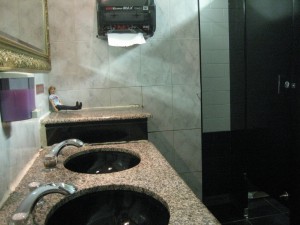 The restrooms for patrons are located up the stairs on the second floor, with three toilets, a urinal and a sink in the men’s room and three toilets and two sinks in the women’s. The green room and office’s eco-friendly toilets have two buttons for flushing depending on how much water you need.
The restrooms for patrons are located up the stairs on the second floor, with three toilets, a urinal and a sink in the men’s room and three toilets and two sinks in the women’s. The green room and office’s eco-friendly toilets have two buttons for flushing depending on how much water you need.
I would like to thank the Blue Note team for the warm welcome, the exclusive backstage toilet tour and the pinball tutorial. New York is the biggest little city, where it’s easy to feel like an anonymous nobody as you constantly rub shoulders with countless extraordinary people so I’m grateful for the encouragement. I must say that recognition as “the toilet girl” is much less pressure than my previous role as somewhat of a North Korean expert, though my current role requires just as much research. Also, you don’t have to worry about hate mail or being blacklisted when you cover a seemingly noncontroversial topic, such as bathrooms.
In actuality, bathrooms can be highly controversial. What does it mean when there are exactly two types of restrooms, one marked male and another marked female? What does the lack of diaper changing stations in men’s rooms signify? What about the scarcity of water and sanitation facilities in many parts of our world? There’s enough fodder there for an entire series of books that could be titled The Subversive Politics of Toilets.
But what do I know? I’m just a music student in a conservatory bubble.
And I hope be fully present my final year in the bubble, not wishing away the weekdays waiting for the weekend. I am amazed to have become a part of the city’s narrative in the midst of living here for school, as I remember thinking about New York eleven years ago today.
Lionel Loueke who emigrated from Benin tells us how to say, “Where’s the restroom?” in Fon –
The Stone
Posted: August 28, 2012 Filed under: East Village | Tags: TUESDAY TOILET TALK 1 Comment »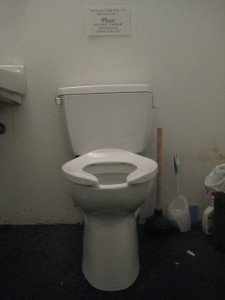 They say time flies. I blinked and ended up back at The Stone, the first music venue I checked out after moving here a year ago. I told myself last time to not return in the summer, as it gets unbearably stuffy in the small rectangular room when the noisy air conditioner is turned off during the performance. But I forgot about that. Thankfully, the weather this past Tuesday was relatively cool and the A/C was kept on for the second piece.
They say time flies. I blinked and ended up back at The Stone, the first music venue I checked out after moving here a year ago. I told myself last time to not return in the summer, as it gets unbearably stuffy in the small rectangular room when the noisy air conditioner is turned off during the performance. But I forgot about that. Thankfully, the weather this past Tuesday was relatively cool and the A/C was kept on for the second piece.
With my glasses sliding over the bridge of my nose from perspiration, my mind began to wander as I listened to the interaction between Pauline Oliveros (digital accordion), Susie Ibarra (drums) and Thollem McDonas (piano). I remembered the time I participated in Pauline’s workshop some years ago and the San Francisco Electronic Music Festival, where I heard her play duo with laptop, wishing I had earplugs to deflect the shimmery, metallic vibrations. I remembered the electric energy of spontaneous music making with strong improvisers committed not to a specific musical idiom, but to the moment. I remembered a little piece of myself that I had forgotten.
 Along with the Village Vanguard’s ladies stalls, The Stone’s unisex restroom provided the impetus for this blog. Located immediately behind the performance area, there is no way that you or anyone else watching the show can miss the entrance to the restroom. And with just a flimsy button lock on the doorknob, you feel as though someone might accidentally fling the door open on you, making your private potty time a part of the performance. If you obey the sign discouraging bathroom use during the performance however, you won’t have to worry about having to improvise in the hypothetical situation. Just remember to use the bathroom during the break.
Along with the Village Vanguard’s ladies stalls, The Stone’s unisex restroom provided the impetus for this blog. Located immediately behind the performance area, there is no way that you or anyone else watching the show can miss the entrance to the restroom. And with just a flimsy button lock on the doorknob, you feel as though someone might accidentally fling the door open on you, making your private potty time a part of the performance. If you obey the sign discouraging bathroom use during the performance however, you won’t have to worry about having to improvise in the hypothetical situation. Just remember to use the bathroom during the break.
I went equipped with hand sanitizer and was pleased to see that they had soap this time, $2.99 plus tax from Adinah’s Farm market across the street. Maintaining restrooms, from purchasing the hand soap and toilet paper to calling the plumber costs money and I wondered how The Stone runs. This is the only club I know of in the city that does not sell drinks and has select musicians curate shows, with all cover revenue going directly to the performers.
As I continue to publish posts, I’m starting to exhaust the more commonly found languages for the concluding audio clip. I had counted on getting Tagalog for this issue but the person eventually and politely declined. You can tell quite a bit about one’s personality just by asking if you could record him/her saying “Where’s the restroom?” Some people don’t think twice, maybe laugh then say it, while others are much more cautious. It probably doesn’t put the careful personalities any more at ease when I say it’s for a blog on toilets. Please do warn friends that play or attend jazz clubs about JAZZ TOILET so that they are not taken aback when I pop the question.
A Spanish friend told me that there are some 6000 languages in the world and that there are 4 in his nation alone. I’m not sure how many are spoken in NYC but there are certainly more than I can cover in the lifetime of this blog. Cătălin from Romania tells us how to say, “Where’s the restroom?” in Romanian —
Ginny’s Supper Club
Posted: August 14, 2012 Filed under: Harlem | Tags: TUESDAY TOILET TALK 4 Comments »The air thick from too many people packed into the tight space, I slowly nudged my way toward the front until I could see bandleader Christian Scott. My brain’s immediate response: “He is brave; he is wearing polka dots. He is a trumpet player.” His music was as remarkable as his outfit and fitting of the rare man who can pull off polka dots. Joined by Matt Stevens (guitar), Lawrence Fields (piano), Kris Funn (bass) and Joe Dyson (drums), the band celebrated the release of a new album the Thursday before last at Ginny’s Supper Club.
Christian Scott quickly cleared up my confusion as to whether the venue was supposed to be a listening room or a lounge with background music when he told the audience in the back to shut up. True to his outspoken personality, he continued with his piece K.K.P.D. (Ku Klux Police Department), providing the backstory and commenting on the fact that these things are still happening today. I can believe that.
While I personally only know what it’s like to be an Asian woman in metropolitan areas, I’m certain that racism toward each of the many groups on the periphery of mainstream America is real. It seems like just yesterday that kids at school were pulling their eyes back, sputtering nonsensical syllables. Oh wait. That was the other day in Harlem when a grown woman called me “ching-ching.”
Hypersensitive? You tell me.
Ginny’s Supper Club has a rather high ratio of people needing to relieve themselves to number of toilets available and shares the two bathrooms with its parent restaurant, Red Rooster, upstairs on the ground level. I hastily investigated the bathroom on the left, remembering to press down gently on the soap pump as to not squirt my shirt like last time, and noted the sparkly chandelier hanging from the ceiling.
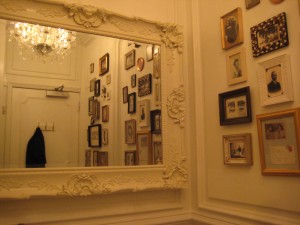 I only glanced briefly at the framed pictures covering the walls but I assume they were supposed to be a throwback to the Harlem Renaissance. Harlem seems to be undergoing a different kind of development now, one of gentrification, as the socioeconomic makeup of the neighborhood gradually changes. The restaurant fits the face of this new Harlem, with a menu that claims to reflect “the roots of Harlem’s diverse population,” but with prices affordable to a select population.
I only glanced briefly at the framed pictures covering the walls but I assume they were supposed to be a throwback to the Harlem Renaissance. Harlem seems to be undergoing a different kind of development now, one of gentrification, as the socioeconomic makeup of the neighborhood gradually changes. The restaurant fits the face of this new Harlem, with a menu that claims to reflect “the roots of Harlem’s diverse population,” but with prices affordable to a select population.
I can’t help but feel a strange sense of irony.
Still, the recently opened venue is noteworthy in that it is under black ownership. How many jazz clubs can you think of that can say that? Or jazz anything that’s under the management of black people, who created the very genre? My sister also reminded me that a key premise to this blog, the toilet as a shared experience for everyone regardless of race or other segregating factors, wasn’t always the case. I have to thank her for providing nuanced insight into this issue’s toilet. It’s no wonder that as kids, she brought home the African-American History Bee trophy while the only shiny thing I brought home was glitter glue.
Stanley from Haiti, who works at the bar, tells us how to say, “Where’s the restroom?” in Creole –
[EDIT] Please see the comments section for a correction to an error in the last paragraph.

